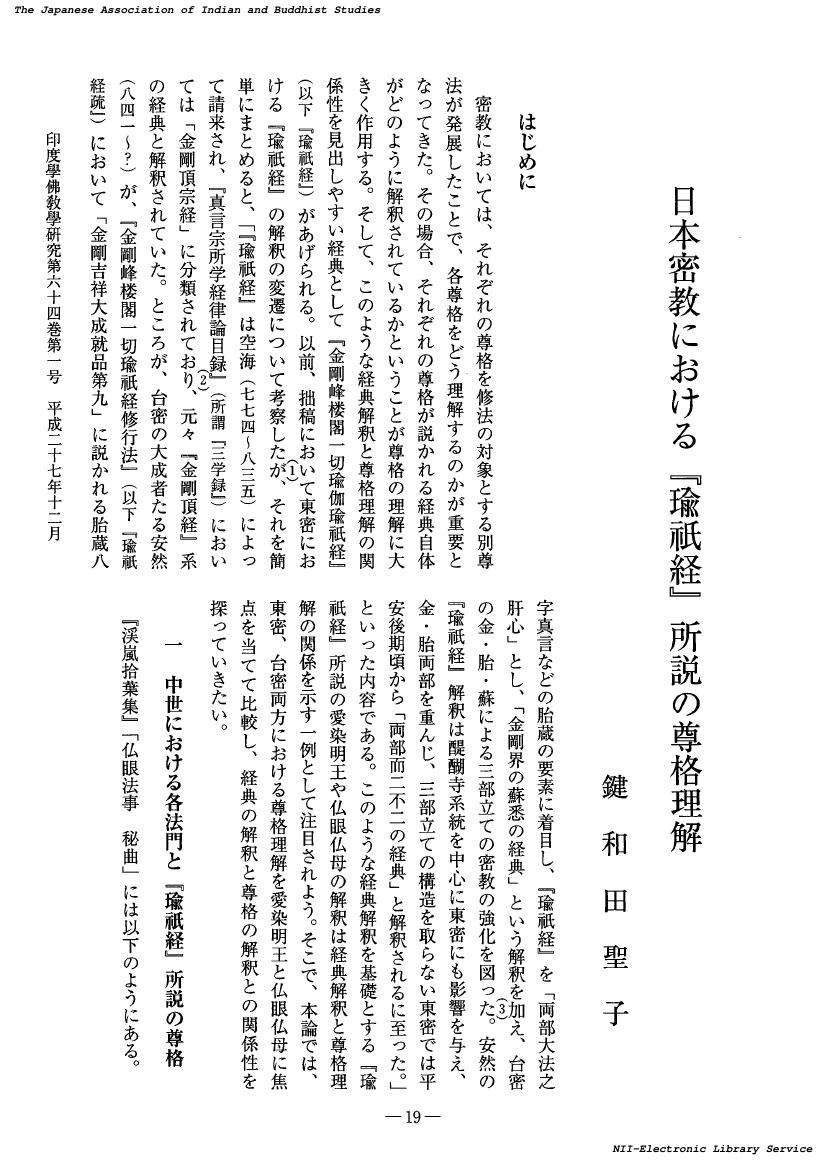3 0 0 0 OA 両頭愛染曼荼羅の成立に関する一考察 金胎不二の図像的表現を中心に
- 著者
- 鍵和田 聖子
- 出版者
- 日本印度学仏教学会
- 雑誌
- 印度學佛教學研究 (ISSN:00194344)
- 巻号頁・発行日
- vol.60, no.2, pp.615-618, 2012-03-20 (Released:2017-09-01)
1 0 0 0 OA 日本密教における『瑜祇経』所説の尊格理解
- 著者
- 鍵和田 聖子
- 出版者
- 日本印度学仏教学会
- 雑誌
- 印度學佛教學研究 (ISSN:00194344)
- 巻号頁・発行日
- vol.64, no.1, pp.19-24, 2015-12-20 (Released:2017-09-01)
1 0 0 0 IR 「自殺」と「地獄」の因果関係 : 『往生要集』所引の『正法念処経』を手掛かりとして (創設五十周年記念特集号) -- (大正新脩大蔵経の学術用語に関する研究 : 自殺関連用語の研究)
- 著者
- 淺田 正博 長谷川 岳史 野呂 靖 大谷 由香 鶴田 大悟 村上 明也 小野嶋 祥雄 鍵和田 聖子
- 出版者
- 龍谷大学佛教文化研究所
- 雑誌
- 龍谷大学仏教文化研究所紀要 (ISSN:02895544)
- 巻号頁・発行日
- vol.50, pp.84-97, 2011
1 0 0 0 OA 長野賞論文 日本の密教曼陀羅と神仏習合
- 著者
- 鍵和田 聖子
- 出版者
- 東洋英和女学院大学
- 雑誌
- 東洋英和大学院紀要 (ISSN:13497715)
- 巻号頁・発行日
- no.1, pp.53-72, 2005
This is a study of mandalas unique to Esoteric Buddhism and the influence they had on religious developments in Japan, especially in terms of movements toward a union of Buddhism and Shintoism. Several sites of esoteric Buddhism are examined, including Koyasan, Hieizan, Kumano, and stone images of the Buddha found in Oita Prefecture. Since ancient times, natural phenomen, especially mountains, were considered as gods or kami in Japan. This polytheistic nature of Shinto agreed with Buddhism, and allowed Japanese to believe that the Buddha could be identified with the Japanese gods.This identification between Buddhist deities and nature influenced the themes portrayed in Buddhist iconography, particularly the mandala. The lack of a sense of the absolute also contributed to change in the construction of mandalas. Furthermore, these "emblems of the other world" were somewhat more malleable in Japan, perhaps because Japanese themselves felt so close to the other world. In was through this indigenization of the mandala that we can see the indigenization of Buddhism, that is the transformation of Buddhism into a Japanese religion.
- 著者
- 鍵和田 聖子
- 出版者
- 日本印度学仏教学会
- 雑誌
- 印度學佛教學研究 (ISSN:00194344)
- 巻号頁・発行日
- vol.57, no.2, pp.604-607, 2009-03
1 0 0 0 OA 東寺講堂立体曼荼羅の思想的背景
- 著者
- 鍵和田 聖子
- 出版者
- 龍谷大学
- 雑誌
- 龍谷大学大学院文学研究科紀要 (ISSN:13433695)
- 巻号頁・発行日
- vol.28, pp.140-156, 2006


